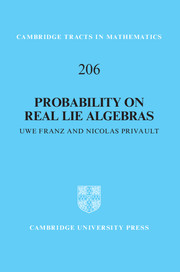Book contents
- Frontmatter
- Dedication
- Contents
- Notation
- Preface
- Introduction
- 1 Boson Fock space
- 2 Real Lie algebras
- 3 Basic probability distributions on Lie algebras
- 4 Noncommutative random variables
- 5 Noncommutative stochastic integration
- 6 Random variables on real Lie algebras
- 7 Weyl calculus on real Lie algebras
- 8 Lévy processes on real Lie algebras
- 9 A guide to the Malliavin calculus
- 10 Noncommutative Girsanov theorem
- 11 Noncommutative integration by parts
- 12 Smoothness of densities on real Lie algebras
- Appendix
- Exercise solutions
- References
- Index
Introduction
Published online by Cambridge University Press: 05 February 2016
- Frontmatter
- Dedication
- Contents
- Notation
- Preface
- Introduction
- 1 Boson Fock space
- 2 Real Lie algebras
- 3 Basic probability distributions on Lie algebras
- 4 Noncommutative random variables
- 5 Noncommutative stochastic integration
- 6 Random variables on real Lie algebras
- 7 Weyl calculus on real Lie algebras
- 8 Lévy processes on real Lie algebras
- 9 A guide to the Malliavin calculus
- 10 Noncommutative Girsanov theorem
- 11 Noncommutative integration by parts
- 12 Smoothness of densities on real Lie algebras
- Appendix
- Exercise solutions
- References
- Index
Summary
Mathematics is the tool specially suited for dealing with abstract concepts of any kind and there is no limit to its power in this field.
(P.A.M. Dirac, in The Principles of Quantum Mechanics.)Quantum probability addresses the challenge of merging the apparently distinct domains of algebra and probability, in view of physical applications. Those fields typically involve radically different types of thinking, which are not often mastered simultaneously. Indeed, the framework of algebra is often abstract and noncommutative while probability addresses the “fluctuating” but classical notion of a random variable, and requires a good amount of statistical intuition. On the other hand, those two fields combined yield natural applications, for e.g., quantum mechanics. On a more general level, the noncommutativity of operations is a common real life phenomenon which can be connected to classical probability via quantum mechanics. Algebraic approaches to probability also have applications in theoretical computer science, cf. e.g., [39].
In the framework of this noncommutative (or algebraic) approach to probability, often referred to as quantum probability, real-valued random variables on a classical probability space become special examples of noncommutative (or quantum) random variables. For this, a real-valued random variable on a probability space (Ω, F, P) is viewed as (unbounded) self-adjoint multiplication operators acting on the Hilbert space L2(Ω, P). This has led to the suggestion by several authors to develop a theory of quantum probability within the framework of operators and group representations in a Hilbert space, cf. [87] and references therein.
In this monograph, our approach is to focus on the links between the commutation relations within a given noncommutative algebra A on the one hand, and the combinatorics of the moments of a given probability distribution on the other hand. This approach is exemplified in Chapters 1–3. In this respect our point of view is consistent with the description of quantum probability by P.A. Meyer in [80] as a set of prescriptions to extract probability from algebra, based on various choices for the algebra A.
For example, it is a well-known fact that the Gaussian distribution arises from the Heisenberg–Weyl algebra which is generated by three elements {P, Q, I} linked by the commutation relation
It turns out similarly that other infinitely divisible distributions such as the gamma and continuous binomial distributions can be constructed via noncommutative random variables using representations of the special linear algebra sl2(R), …
- Type
- Chapter
- Information
- Probability on Real Lie Algebras , pp. xv - xxPublisher: Cambridge University PressPrint publication year: 2016



